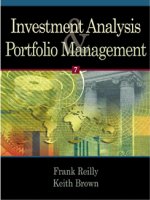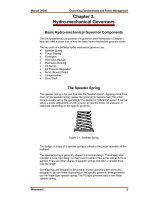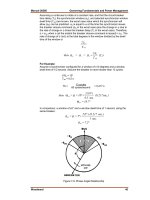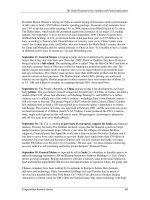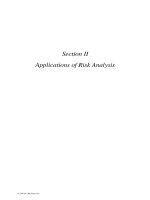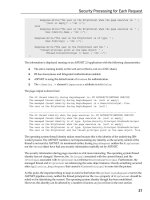advances in Investment Analysis and Portfolio Management phần 2 potx
Bạn đang xem bản rút gọn của tài liệu. Xem và tải ngay bản đầy đủ của tài liệu tại đây (234.05 KB, 16 trang )
Investment Analysis and Portfolio Management
18
and other commodities). But in this course the target is on derivatives where
underlying asset is a financial asset.
Other investment tools:
• Various types of investment funds;
• Investment life insurance;
• Pension funds;
• Hedge funds.
Investment companies/ investment funds. They receive money from investors
with the common objective of pooling the funds and then investing them in securities
according to a stated set of investment objectives.
Two types of funds:
• open-end funds (mutual funds) ,
• closed-end funds (trusts).
Open-end funds have no pre-determined amount of stocks outstanding and
they can buy back or issue new shares at any point. Price of the share is not determined
by demand, but by an estimate of the current market value of the fund’s net assets per
share (NAV) and a commission.
Closed-end funds are publicly traded investment companies that have issued a
specified number of shares and can only issue additional shares through a new public
issue. Pricing of closed-end funds is different from the pricing of open-end funds: the
market price can differ from the NAV.
Insurance Companies are in the business of assuming the risks of adverse
events (such as fires, accidents, etc.) in exchange for a flow of insurance premiums.
Insurance companies are investing the accumulated funds in securities (treasury bonds,
corporate stocks and bonds), real estate.
Three types of Insurance Companies: life
insurance; non-life insurance (also known as property-casualty insurance) and re-
insurance. During recent years investment life insurance became very popular
investment alternative for individual investors, because this hybrid investment product
allows to buy the life insurance policy together with possibility to invest accumulated
life insurance payments or lump sum for a long time selecting investment program
relevant to investor‘s future expectations.
Pension Funds are an asset pools that accumulates over an employee’s working
years and pays retirement benefits during the employee’s nonworking years. Pension
Investment Analysis and Portfolio Management
19
funds are investing the funds according to a stated set of investment objectives in
securities (treasury bonds, corporate stocks and bonds), real estate.
Hedge funds are unregulated private investment partnerships, limited to
institutions and high-net-worth individuals, which seek to exploit various market
opportunities and thereby to earn larger returns than are ordinarily available. They
require a substantial initial investment from investors and usually have some
restrictions on how quickly investor can withdraw their funds. Hedge funds take
concentrated speculative positions and can be very risky. It could be noted that
originally, the term “hedge” made some sense when applied to these funds. They
would by combining different types of investments, including derivatives, try to hedge
risk while seeking higher return. But today the word “hedge’ is misapplied to these
funds because they generally take an aggressive strategies investing in stock, bond and
other financial markets around the world and their level of risk is high.
1.3.2. Financial markets
Financial markets are the other important component of investment
environment.
Financial markets are designed to allow corporations and governments to raise new
funds and to allow investors to execute their buying and selling orders. In financial
markets funds are channeled from those with the surplus, who buy securities, to those,
with shortage, who issue new securities or sell existing securities. A financial market
can be seen as a set of arrangements that allows trading among its participants.
Financial market provides three important economic functions (Frank J.
Fabozzi, 1999):
1. Financial market determines the prices of assets traded through the
interactions between buyers and sellers;
2. Financial market provides a liquidity of the financial assets;
3. Financial market reduces the cost of transactions by reducing explicit costs,
such as money spent to advertise the desire to buy or to sell a financial
asset.
Financial markets could be classified on the bases of those characteristics:
• Sequence of transactions for selling and buying securities;
• Term of circulation of financial assets traded in the market;
• Economic nature of securities, traded in the market;
Investment Analysis and Portfolio Management
20
• From the perspective of a given country.
By sequence of transactions for selling and buying securities:
Primary market
Secondary market
All securities are first traded in the primary market, and the secondary market
provides liquidity for these securities.
Primary market is where corporate and government entities can raise capital
and where the first transactions with the new issued securities are performed. If a
company’s share is traded in the primary market for the first time this is referred to as
an initial public offering (IPO).
Investment banks play an important role in the primary market:
• Usually handle issues in the primary market;
• Among other things, act as underwriter of a new issue, guaranteeing the
proceeds to the issuer.
Secondary market - where previously issued securities are traded among
investors. Generally, individual investors do not have access to secondary markets.
They use security brokers to act as intermediaries for them. The broker delivers an
orders received form investors in securities to a market place, where these orders are
executed. Finally, clearing and settlement processes ensure that both sides to these
transactions honor their commitment. Types of brokers:
• Discount broker, who executes only trades in the secondary market;
• Full service broker, who provides a wide range of additional services to
clients (ex., advice to buy or sell);
• Online broker is a brokerage firm that allows investors to execute trades
electronically using Internet.
Types of secondary market places:
• Organized security exchanges;
• Over-the-counter markets;
• Alternative trading system.
An organized security exchange provides the facility for the members to trade
securities, and only exchange members may trade there. The members include
brokerage firms, which offer their services to individual investors, charging
commissions for executing trades on their behalf. Other exchange members by or sell
Investment Analysis and Portfolio Management
21
for their own account, functioning as dealers or market makers who set prices at which
they are willing to buy and sell for their own account. Exchanges play very important
role in the modern economies by performing the following tasks:
• Supervision of trading to ensure fairness and efficiency;
• The authorization and regulation of market participants such as brokers
and market makers;
• Creation of an environment in which securities’ prices are formed
efficiently and without distortion. This requires not only regulation of an
orders and transaction costs but also a liquid market in which there are
many buyers and sellers, allowing investors to buy or to sell their securities
quickly;
• Organization of the clearing and settlement of transactions;
• The regulation of he admission of companies to be listed on the exchange
and the regulation of companies who are listed on the exchange;
• The dissemination of information (trading data, prices and announcements
of companies listed on the exchange). Investors are more willing to trade if
prompt and complete information about trades and prices in the market is
available.
The over-the-counter (OTC) market is not a formal exchange. It is organized
network of brokers and dealers who negotiate sales of securities. There are no
membership requirements and many brokers register as dealers on the OTC. At the
same time there are no listing requirements and thousands of securities are traded in
the OTC market. OTC stocks are usually considered as very risky because they are the
stocks that are not considered large or stable enough to trade on the major exchange.
An alternative trading system (ATS) is an electronic trading mechanism
developed independently from the established market places – security exchanges –
and designed to match buyers and sellers of securities on an agency basis. The brokers
who use ATS are acting on behalf of their clients and do not trade on their own
account. The distinct advantages of ATS in comparison with traditional markets are
cost savings of transactions, the short time of execution of transactions for liquid
securities, extended hours for trading and anonymity, often important for investors,
trading large amounts.
By term of circulation of financial assets traded in the market:
Investment Analysis and Portfolio Management
22
Money market;
Capital market
Money market - in which only short-term financial instruments are traded.
Capital market - in which only long-term financial instruments are traded.
The capital markets allow firms, governments to finance spending in excess of their
current incomes.
Table 1.2.
The comparison of money market and capital market
Features
Money market Capital market
Term of circulation of
securities traded
Short-term,
less than 1 year
Long-term,
more than 1 year
Level of risk Low, because of trading
short-term securities which
have lower level of risk
and high liquidity
Long-term securities,
traded in this market, is
more risky
Fund suppliers Commercial banks, non-
financial business
institutions with the excess
funds
Banks, insurance
companies, pension funds,
lending the large amounts
of funds for a long-term
period; investment funds
with big pools of funds for
investing
Financial instruments Certificates of deposit;
Treasury bills;
Commercial paper;
Bankers’ acceptances;
Repurchase agreements,
other short-term
investment vehicles
Common stocks;
Preferred stocks;
Treasury bonds;
Municipal bonds;
Corporate bonds;
other long-term investment
vehicles
Aims for raising money For financing of working
capital and current needs
For financing of further
business development and
investment projects
By economic nature of securities, traded in the market:
Equity market or stock market;
Common stock market;
Fixed-income market;
Debt market;
Derivatives market.
From the perspective of a given country financial markets are:
Internal or national market;
Investment Analysis and Portfolio Management
23
External or international market.
The internal market can be split into two fractions: domestic market and
foreign market. Domestic market is where the securities issued by domestic issuers
(companies, Government) are traded. A country’s foreign market is where the
securities issued by foreign entities are traded.
The external market also is called the international market includes the
securities which are issued at the same time to the investors in several countries and
they are issued outside the jurisdiction of any single country (for example, offshore
market).
Globalization and integration processes include the integration of financial
markets into an international financial market. Because of the globalization of financial
markets, potential issuers and investors in any country become not limited to their
domestic financial market.
1.4. Investment management process
Investment management process is the process of managing money or funds.
The investment management process describes how an investor should go about
making decisions.
Investment management process can be disclosed by five-step procedure,
which includes following stages:
1. Setting of investment policy.
2. Analysis and evaluation of investment vehicles.
3. Formation of diversified investment portfolio.
4. Portfolio revision
5. Measurement and evaluation of portfolio performance.
Setting of investment policy is the first and very important step in investment
management process. Investment policy includes setting of investment objectives. The
investment policy should have the specific objectives regarding the investment return
requirement and risk tolerance of the investor. For example, the investment policy may
define that the target of the investment average return should be 15 % and should
avoid more than 10 % losses. Identifying investor’s tolerance for risk is the most
important objective, because it is obvious that every investor would like to earn the
highest return possible. But because there is a positive relationship between risk and
return, it is not appropriate for an investor to set his/ her investment objectives as just
Investment Analysis and Portfolio Management
24
“to make a lot of money”. Investment objectives should be stated in terms of both risk
and return.
The investment policy should also state other important constrains which could
influence the investment management. Constrains can include any liquidity needs for
the investor, projected investment horizon, as well as other unique needs and
preferences of investor. The investment horizon is the period of time for investments.
Projected time horizon may be short, long or even indefinite.
Setting of investment objectives for individual investors is based on the
assessment of their current and future financial objectives. The required rate of return
for investment depends on what sum today can be invested and how much investor
needs to have at the end of the investment horizon. Wishing to earn higher income on
his / her investments investor must assess the level of risk he /she should take and to
decide if it is relevant for him or not. The investment policy can include the tax status
of the investor. This stage of investment management concludes with the identification
of the potential categories of financial assets for inclusion in the investment portfolio.
The identification of the potential categories is based on the investment objectives,
amount of investable funds, investment horizon and tax status of the investor. From the
section 1.3.1 we could see that various financial assets by nature may be more or less
risky and in general their ability to earn returns differs from one type to the other. As
an example, for the investor with low tolerance of risk common stock will be not
appropriate type of investment.
Analysis and evaluation of investment vehicles. When the investment policy
is set up, investor’s objectives defined and the potential categories of financial assets
for inclusion in the investment portfolio identified, the available investment types can
be analyzed. This step involves examining several relevant types of investment
vehicles and the individual vehicles inside these groups. For example, if the common
stock was identified as investment vehicle relevant for investor, the analysis will be
concentrated to the common stock as an investment. The one purpose of such analysis
and evaluation is to identify those investment vehicles that currently appear to be
mispriced. There are many different approaches how to make such analysis. Most
frequently two forms of analysis are used: technical analysis and fundamental analysis.
Technical analysis involves the analysis of market prices in an attempt to
predict future price movements for the particular financial asset traded on the market.
Investment Analysis and Portfolio Management
25
This analysis examines the trends of historical prices and is based on the assumption
that these trends or patterns repeat themselves in the future. Fundamental analysis in its
simplest form is focused on the evaluation of intrinsic value of the financial asset. This
valuation is based on the assumption that intrinsic value is the present value of future
flows from particular investment. By comparison of the intrinsic value and market
value of the financial assets those which are under priced or overpriced can be
identified. Fundamental analysis will be examined in Chapter 4.
This step involves identifying those specific financial assets in which to
invest and determining the proportions of these financial assets in the investment
portfolio.
Formation of diversified investment portfolio is the next step in investment
management process. Investment portfolio is the set of investment vehicles, formed by
the investor seeking to realize its’ defined investment objectives. In the stage of
portfolio formation the issues of selectivity, timing and diversification need to be
addressed by the investor. Selectivity refers to micro forecasting and focuses on
forecasting price movements of individual assets. Timing involves macro forecasting
of price movements of particular type of financial asset relative to fixed-income
securities in general. Diversification involves forming the investor’s portfolio for
decreasing or limiting risk of investment. 2 techniques of diversification:
• random diversification, when several available financial assets are put to
the portfolio at random;
• objective diversification when financial assets are selected to the portfolio
following investment objectives and using appropriate techniques for
analysis and evaluation of each financial asset.
Investment management theory is focused on issues of objective portfolio
diversification and professional investors follow settled investment objectives then
constructing and managing their portfolios.
Portfolio revision. This step of the investment management process concerns
the periodic revision of the three previous stages. This is necessary, because over time
investor with long-term investment horizon may change his / her investment objectives
and this, in turn means that currently held investor’s portfolio may no longer be
optimal and even contradict with the new settled investment objectives. Investor
should form the new portfolio by selling some assets in his portfolio and buying the
Investment Analysis and Portfolio Management
26
others that are not currently held. It could be the other reasons for revising a given
portfolio: over time the prices of the assets change, meaning that some assets that were
attractive at one time may be no longer be so. Thus investor should sell one asset ant
buy the other more attractive in this time according to his/ her evaluation. The
decisions to perform changes in revising portfolio depend, upon other things, in the
transaction costs incurred in making these changes. For institutional investors portfolio
revision is continuing and very important part of their activity. But individual investor
managing portfolio must perform portfolio revision periodically as well. Periodic re-
evaluation of the investment objectives and portfolios based on them is necessary,
because financial markets change, tax laws and security regulations change, and other
events alter stated investment goals.
Measurement and evaluation of portfolio performance. This the last step in
investment management process involves determining periodically how the portfolio
performed, in terms of not only the return earned, but also the risk of the portfolio. For
evaluation of portfolio performance appropriate measures of return and risk and
benchmarks are needed. A benchmark is the performance of predetermined set of
assets, obtained for comparison purposes. The benchmark may be a popular index of
appropriate assets – stock index, bond index. The benchmarks are widely used by
institutional investors evaluating the performance of their portfolios.
It is important to point out that investment management process is continuing
process influenced by changes in investment environment and changes in investor’s
attitudes as well. Market globalization offers investors new possibilities, but at the
same time investment management become more and more complicated with growing
uncertainty.
Summary
1. The common target of investment activities is to “employ” the money (funds)
during the time period seeking to enhance the investor’s wealth. By foregoing
consumption today and investing their savings, investors expect to enhance their
future consumption possibilities by increasing their wealth.
2. Corporate finance area of studies and practice involves the interaction between
firms and financial markets and Investments area of studies and practice involves
the interaction between investors and financial markets. Both Corporate Finance
and Investments are built upon a common set of financial principles, such as the
Investment Analysis and Portfolio Management
27
present value, the future value, the cost of capital). And very often investment and
financing analysis for decision making use the same tools, but the interpretation of
the results from this analysis for the investor and for the financier would be
different.
3. Direct investing is realized using financial markets and indirect investing involves
financial intermediaries. The primary difference between these two types of
investing is that applying direct investing investors buy and sell financial assets
and manage individual investment portfolio themselves; contrary, using indirect
type of investing investors are buying or selling financial instruments of financial
intermediaries (financial institutions) which invest large pools of funds in the
financial markets and hold portfolios. Indirect investing relieves investors from
making decisions about their portfolio.
4. Investment environment can be defined as the existing investment vehicles in the
market available for investor and the places for transactions with these investment
vehicles.
5. The most important characteristics of investment vehicles on which bases the
overall variety of investment vehicles can be assorted are the return on investment
and the risk which is defined as the uncertainty about the actual return that will be
earned on an investment. Each type of investment vehicles could be characterized
by certain level of profitability and risk because of the specifics of these financial
instruments. The main types of financial investment vehicles are: short- term
investment vehicles; fixed-income securities; common stock; speculative
investment vehicles; other investment tools.
6. Financial markets are designed to allow corporations and governments to raise new
funds and to allow investors to execute their buying and selling orders. In financial
markets funds are channeled from those with the surplus, who buy securities, to
those, with shortage, who issue new securities or sell existing securities.
7. All securities are first traded in the primary market, and the secondary market
provides liquidity for these securities. Primary market is where corporate and
government entities can raise capital and where the first transactions with the new
issued securities are performed. Secondary market - where previously issued
securities are traded among investors. Generally, individual investors do not have
Investment Analysis and Portfolio Management
28
access to secondary markets. They use security brokers to act as intermediaries for
them.
8. Financial market, in which only short-term financial instruments are traded, is
Money market, and financial market in which only long-term financial instruments
are traded is Capital market.
9. The investment management process describes how an investor should go about
making decisions. Investment management process can be disclosed by five-step
procedure, which includes following stages: (1) setting of investment policy; (2)
analysis and evaluation of investment vehicles; (3) formation of diversified
investment portfolio; (4) portfolio revision; (5) measurement and evaluation of
portfolio performance.
10. Investment policy includes setting of investment objectives regarding the
investment return requirement and risk tolerance of the investor. The other
constrains which investment policy should include and which could influence the
investment management are any liquidity needs, projected investment horizon and
preferences of the investor.
11. Investment portfolio is the set of investment vehicles, formed by the investor
seeking to realize its’ defined investment objectives. Selectivity, timing and
diversification are the most important issues in the investment portfolio formation.
Selectivity refers to micro forecasting and focuses on forecasting price movements
of individual assets. Timing involves macro forecasting of price movements of
particular type of financial asset relative to fixed-income securities in general.
Diversification involves forming the investor’s portfolio for decreasing or limiting
risk of investment.
Key-terms
• Alternative trading system
(ATS)
• Broker
• Capital market
• Closed-end funds
• Common stock
• Debt securities
• Derivatives
• Direct investing
• Diversification
• Financial institutions
• Financial intermediaries
• Financial investments
• Financial markets
• Indirect investing
• Institutional investors
Investment Analysis and Portfolio Management
29
• Investment
• Investment environment
• Investment vehicles
• Investment management
process
• Investment policy
• Investment horizon
• Investment management
• Investment funds
• Investment portfolio
• Investment life insurance
• Hedge funds
• Investment portfolio
• Long-term investments
• Money market
• Open-end funds
• Organized security exchange
• Over-the-counter (OTC)
market
• Pension funds
• Primary market
• Preferred stock
• Real investments
• Secondary market
• Short-term investments
• Speculation
• Speculative investment
Questions and problems
1. Distinguish investment and speculation.
2. Explain the difference between direct and indirect investing.
3. How could you describe the investment environment?
4. Classify the following types of financial assets as long-term and short term:
a) Repurchase agreements
b) Treasury Bond
c) Common stock
d) Commercial paper
e) Preferred Stock
f) Certificate of Deposit
5. Comment the differences between investment in financial and physical assets
using following characteristics:
a) Divisibility
b) Liquidity
c) Holding period
d) Information ability
6. Why preferred stock is called hybrid financial security?
7. Why Treasury bills considered being a risk free investment?
Investment Analysis and Portfolio Management
30
8. Describe how investment funds, pension funds and life insurance companies each
act as financial intermediaries.
9. Distinguish closed-end funds and open-end funds.
10. How do you understand why word “hedge’ currently is misapplied to hedge
funds?
11. Explain the differences between
a) Money market and capital market;
b) Primary market and secondary market.
12. Why the role of the organized stock exchanges is important in the modern
economies?
13. What factors might an individual investor take into account in determining his/
her investment policy?
14. Define the objective and the content of a five-step procedure.
15. What are the differences between technical and fundamental analysis?
16. Explain why the issues of selectivity, timing and diversification are important
when forming the investment portfolio.
17. Think about your investment possibilities for 3 years holding period in real
investment environment.
a) What could be your investment objectives?
b) What amount of funds you could invest for 3 years period?
c) What investment vehicles could you use for investment? (What types of
investment vehicles are available in your investment environment?)
d) What type(-es) of investment vehicles would be relevant to you? Why?
e) What factors would be critical for your investment decision making in
this particular investment environment?
References and further readings
1. Black, John, Nigar Hachimzade, Gareth Myles (2009). Oxford Dictionary of
Economics. 3
rd
ed. Oxford University Press Inc., New York.
2. Bode, Zvi, Alex Kane, Alan J. Marcus (2005). Investments. 6th ed. McGraw
Hill.
3. Fabozzi, Frank J. (1999). Investment Management. 2nd. ed. Prentice Hall Inc.
4. Francis, Jack C., Roger Ibbotson (2002). Investments: A Global Perspective.
Prentice Hall Inc.
Investment Analysis and Portfolio Management
31
5. Haan, Jakob, Sander Oosterloo, Dirk Schoenmaker (2009).European Financial
Markets and Institutions. Cambridge University Press.
6. Jones, Charles P. (2010). Investments Principles and Concepts. John Wiley &
Sons, Inc.
7. LeBarron, Dean, Romesh Vaitlingam (1999). Ultimate Investor. Capstone.
8. Levy, Haim, Thierry Post (2005). Investments. FT / Prentice Hall.
9. Rosenberg, Jerry M. (1993).Dictionary of Investing. John Wiley &Sons Inc.
10. Sharpe, William F. Gordon J.Alexander, Jeffery V.Bailey. (1999). Investments.
International edition. Prentice –Hall International.
Relevant websites
• www.cmcmarkets.co.uk CMC Markets
• www.dcxworld.com Development Capital Exchange
• www.euronext.com Euronext
• www.nasdaqomx.com NASDAQ OMX
• www.world-exchanges.org World Federation of Exchange
• www.hedgefund.net Hedge Fund
• www.liffeinvestor.com Information and learning tools from LIFFE to
help the private investor
• www.amfi.com Association of Mutual Funds Investors
• www.standardpoors.com Standard &Poors Funds
• www.bloomberg.com/markets Bloomberg
Investment Analysis and Portfolio Management
32
2. Quantitative methods of investment analysis
Mini-contents
2.1. Investment income and risk.
2.1.1. Return on investment and expected rate of return.
2.1.2. Investment risk. Variance and standard deviation.
2.2. Relationship between risk and return.
2.2.1. Covariance.
2.2.2. Correlation and Coefficient of determination.
2.3. Relationship between the returns on asset and market portfolio
2.3.1. The characteristic line and the Beta factor.
2.3.2. Residuale variance.
Summary
Key terms
Questions and problems
References and further readings
3 basic questions for the investor in decision making:
1. How to compare different assets in investment selection process? What are
the quantitative characteristics of the assets and how to measure them?
2. How does one asset in the same portfolio influence the other one in the
same portfolio? And what could be the influence of this relationship to the investor’s
portfolio?
3. What is relationship between the returns on an asset and returns in the
whole market (market portfolio)?
The answers of these questions need quantitative methods of analysis, based on
the statistical concepts and they will be examined in this chapter.
2.1. Investment income and risk
A return is the ultimate objective for any investor. But a relationship between
return and risk is a key concept in finance. As finance and investments areas are built
upon a common set of financial principles, the main characteristics of any investment
are investment return and risk. However to compare various alternatives of
investments the precise quantitative measures for both of these characteristics are
needed.
2.1.1. Return on investment and expected rate of return
General definition of return is the benefit associated with an investment. In
most cases the investor can estimate his/ her historical return precisely.
Investment Analysis and Portfolio Management
33
Many investments have two components of their measurable return:
a capital gain or loss;
some form of income.
The rate of return is the percentage increase in returns associated with the
holding period:
Rate of return = Income + Capital gains / Purchase price (%) (2.1)
For example, rate of return of the share (r) will be estimated:
D + (P
me
- P
mb
)
R = (%)
(2.2)
P
mb
Here D - dividends;
P
mb
- market price of stock at the beginning of holding period;
P
me -
market price of stock at the end of the holding period.
The rate of return, calculated in formulas 2.2 and 2.3 is called holding period
return, because its calculation is independent of the passages of the time. All the
investor knows is that there is a beginning of the investment period and an end. The
percent calculated using this formula might have been earned over one month or other
the year. Investor must be very careful with the interpretation of holding period returns
in investment analysis. Investor can‘t compare the alternative investments using
holding period returns, if their holding periods (investment periods) are different.
Statistical data which can be used for the investment analysis and portfolio formation
deals with a series of holding period returns. For example, investor knows monthly
returns for a year of two stocks. How he/ she can compare these series of returns? In
these cases arithmetic average return or sample mean of the returns (ř) can be
used:
n
∑
∑∑
∑ r
i
i=1
ř = , (2.3)
n
here ri - rate of return in period i;
n - number of observations.
